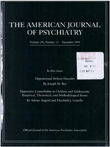Changes in brain glucose metabolism in cocaine dependence and withdrawal
Abstract
OBJECTIVE: The authors investigated changes in brain function associated with cocaine dependence and withdrawal to provide clues regarding the processes that lead to the uncontrollable self- administration of cocaine. METHOD: They measured regional brain metabolism with [18F]-fluorodeoxyglucose (FDG) and positron emission tomography in 15 outpatients with the diagnosis of cocaine abuse and 17 normal comparison subjects. Ten of the patients were studied less than 1 week after they had last had cocaine, and five were studied 2-4 weeks after withdrawal. RESULTS: Patients studied within 1 week of cocaine withdrawal but not those studied within 2-4 weeks of cocaine withdrawal had higher levels of global brain metabolism as well as higher levels of regional brain metabolism in the basal ganglia and orbitofrontal cortex than did normal subjects, probably as a consequence of less brain dopamine activity. There was also a significant relationship between the number of days since cocaine withdrawal and regional brain glucose metabolism in the orbitofrontal cortex and in the basal ganglia, and the correlations between cocaine craving and metabolic activity were significant in the prefrontal cortex and the orbitofrontal cortex. CONCLUSIONS: Although the time-dependent fall in metabolic activity suggests that the higher metabolic activity observed less than a week after cocaine withdrawal may represent a nonspecific expression of drug withdrawal, the selectivity of changes in glucose metabolism for the basal ganglia and for the orbitofrontal cortex suggests that the regional metabolic changes seen in cocaine abusers during detoxification are related to changes in brain dopamine activity.
Access content
To read the fulltext, please use one of the options below to sign in or purchase access.- Personal login
- Institutional Login
- Sign in via OpenAthens
- Register for access
-
Please login/register if you wish to pair your device and check access availability.
Not a subscriber?
PsychiatryOnline subscription options offer access to the DSM-5 library, books, journals, CME, and patient resources. This all-in-one virtual library provides psychiatrists and mental health professionals with key resources for diagnosis, treatment, research, and professional development.
Need more help? PsychiatryOnline Customer Service may be reached by emailing [email protected] or by calling 800-368-5777 (in the U.S.) or 703-907-7322 (outside the U.S.).



